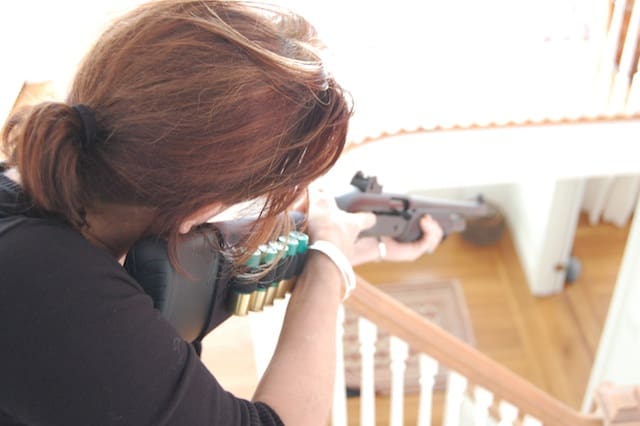[The following article was written by attorney Lisa J. Steele for nacdl.org. It’s republished here with the author’s permission. Click here for part 1.]
The law is well settled that, while a man may kill another in self-defense, he may not do so if he has other probable means of escape. When his back is to the wall, and the question is whether he shall die or his assailant, he may slay his assailant to preserve his own life; but, if he has probable means of escape without doing so, he must resort to such means before he is justified in killing his adversary. Human life is too sacred to be taken unnecessarily.”
– Comm. v. Ware
137 Pa. 465, 479, 20 A. 806 (1890)
A stubborn unwillingness to walk away, even in the face of a perceived affront to the defendant’s manhood, does not equate with an inability to retreat.”
– Com. v. Toon,
55 Mass. App. Ct. 642, 654 (2002)
Duty to Retreat
Unless the client is in his or her own dwelling confronting someone unlawfully within that home, many states impose a duty to retreat from a potential confrontation if the client can do so without increasing his or her own peril. He or she must continue to retreat until there is no probable means of escape.
A growing number of states do not impose a retreat requirement. Indeed, Colorado holds that, if the defendant is not the initial aggressor or engaged in mutual combat, he “is not obliged to retreat or flee to save his life, but may stand his ground, and even, in some circumstances, pursue his assailant until the latter has been disarmed or disabled from carrying into effect his unlawful purpose; and this right of the defendant goes even to the extent, if necessary, of taking human life.” A few states take a middle course: retreat is not required, but a failure to retreat, together with all the other circumstances, can be considered by the jury in determining if there was a case of true self-defense.
If the state does not require retreat, as a practical matter it may still be useful to explain to the jury why retreat was not practical or why the client was unaware of an escape route. If retreat is required, the attorney needs to put on evidence about why it was not possible or safe.
Appellate courts sometimes offer odd ideas about possible avenues of retreat. The attorney needs to establish the client’s physical limitations, if any. Reasonable retreat for a young, healthy person may not be so for someone who is overweight, injured, or disabled. The attorney should establish whether or not the client knew, or should have known, that a possible avenue of retreat existed. In addition, the attorney should establish whether the avenue of retreat was available at the moment the duty to retreat arose. In some jurisdictions, it does not arise until the immediate necessity to use deadly force arises. Under those cases, a client need not retreat until he or she is actually in peril. At that moment, it may not be possible for a client to turn his or her back on the aggressor and flee, especially if there is a firearm involved.
As noted earlier, reconstructing the crime scene for the jury will be very important. The attorney should carefully examine photographs, videotape and sketches. The prosecutor may try to reconstruct the movements of the combatants using witnesses, trace evidence, and blood spatter analysis. Challenge the technical evidence using Daubert and defense experts if necessary. Challenge witnesses’ estimates about distance with expert testimony or, if eyewitness experts are not allowed, with assertions of common knowledge that witnesses are not good at estimating distances.
Is a Warning Required?
It is not clear whether the client must give an attacker a verbal warning before using deadly force. Police officers are required to give “some warning,” “where feasible” before using deadly force on a dangerous escaping suspect.24 They are not required to give a warning before using deadly force in self-defense or defense of another. It is a good idea for the defender to give a warning, and for counsel to show why a warning was not feasible when none was given. However, counsel should resist allowing the prosecutor to create or imply a warning requirement.
Displaying or brandishing a weapon without firing it is often unwise. It may be construed by a prosecutor or a jury as illegally threatening the use of the firearm or weapon, i.e., common law assault, threatening, or other similar offenses. It is also tactically unwise because it may encourage the aggressor to attempt to disarm the client.
There is no reason for a client to fire a warning shot. It would be contrary to public policy for the courts to require, or even encourage, warning shots. First, most handgun bullets are capable of penetrating standard building materials with enough force to injure or even kill someone on the other side of a wall or window. No one should be encouraged to place a bystander at risk by firing such a shot. Second, even if there is an appropriate surface at which to shoot, the client has to take his or her eyes off the aggressor at least for a moment to choose an appropriate target. During that time, the aggressor can attack the client before he or she can bring the firearm back on target. If the client is justified in shooting at all, he or she is justified in shooting at the aggressor.
Initial Aggressors
If the client initiates the attack, he or she is the “initial aggressor.” However, if the client was only the first to use deadly force in response to an imminent danger of serious injury or death, he or she is not necessarily the initial aggressor. Some jurisdictions hold that a defendant who deliberately places himself in a position where his presence will provoke trouble is a kind of initial aggressor and cannot claim self-defense. In states that have not adopted this view, attorneys should be wary of prosecution claims that the client was looking for trouble.
In order to use self-defense, the initial aggressor must abandon his attack and give the then-defender reasonable notice of his retirement from the conflict. At that point, the client’s right to defend himself is restored. If the client draws a weapon and merely hesitates, the then-defender may not be privileged to attack in self-defense.
Mutual Combat
In some states, if the client agreed to a fight with the aggressor, he cannot claim self-defense unless the character of the fight deviates from the agreement. The “mutual combat” preclusion is not found in the Model Penal Code; however, it is found in several state statutes. If the client agrees to a fistfight with a single person and is confronted with a weapon or ambushed by multiple foes, then the client may claim self-defense. The client is still required to retreat, if possible. If the client appears to agree to the raised stakes, however, he may not claim self-defense. In common law jurisdictions, mutual combat may reduce murder to manslaughter by means of provocation.
Mutual combat is most likely to be a difficult issue in cases where the aggressor and the client have a history of disagreements or are members of rival gangs or similar groups. The case may turn on a convoluted history of disagreements and feuds between the parties, and on membership in amorphous youth groups. Attorneys should also be wary of prosecution efforts to interject prejudicial gang membership evidence into the case in the guise of rebutting self-defense using mutual combat.





I still contend that it is best to withdraw when possible even though my state does not have the requirement to withdraw (with certain specific requirements.)
I consider withdrawing to be the best option when possible because:
1. I don’t want to kill anyone, nor do I want me or mine harmed. I want everyone to go home tonight
2. Killing someone, even in an SD friendly state like mine, is a hassle. Even if a criminal court agrees that SD was justified, there is civil court and public opinion
In my home, I won’t withdraw. When with my wife and infant, I won’t because I can’t guarantee their ability to get out of harm’s way. In other situations, I pray that I make the right choice in the split seconds I have to make a life and death decision
This has been an excellent series so far. How many more installments are there, if my asking doesn’t spoil a surprise?
One more. Tomorrow.
Schweeeet =)
Hey Bob,
What happened to installment #5? It hasn’t come through on the RKBA website.
Comments are closed.